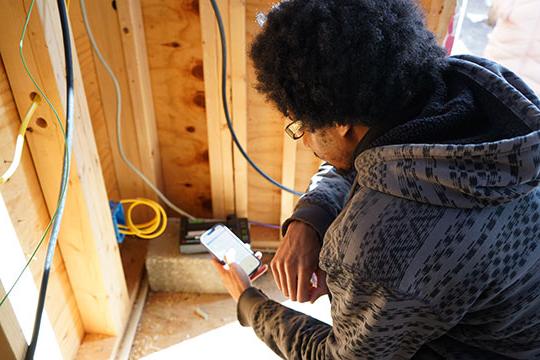Alfred University’s Tiny House to be featured in National Solar Tour

Construction of a tiny house, begun six years ago as a capstone project for three Alfred University renewable energy engineering majors, has drawn the attention of a national organization that advocates for sustainable living.
Alfred University’s tiny house will be part of the 28th annual American Solar Energy Society (ASES) National Solar Tour, scheduled for Oct. 6-8, 2023. Described by ASES as “the largest grassroots solar and sustainable living event in the nation,” the Solar Tour features projects—which can be viewed in person or virtually—which promote sustainability.
ACES is a leading solar energy non-profit advocacy group. The Solar Tour features not just solar energy initiatives, but a host of others which promote sustainability, including electric vehicles, water harvesting and conservation, mechanical heating and cooling, and other, non-solar sources of electric power generation.
Xingwu Wang, professor of electrical engineering in Alfred University’s Inamori School of Engineering, said the tiny house currently being built on campus will be featured both in person and virtually in the upcoming Solar Tour. Students and faculty will lead public demonstrations of the tiny house features, which include a solar-generated power system, as well as a “solar flasher,” a device which can measure the energy harvesting capabilities of photovoltaic (PV) cells designed and built by renewable energy engineering students.
Construction of the tiny house at Alfred University dates back to the fall of 2017, when students Matt Finley, Zach Mapes and Seneca Collins proposed it as the capstone project for their bachelor’s degree in renewable energy engineering. Finley, Mapes and Collins earned their degrees in 2018. Finley and Mapes went on to earn MBA degrees from Alfred University, in December 2018 and 2019, respectively.
During the 2017-18 academic year, students from Alfred University as well a group of students from Alfred State College majoring in building trades, constructed the frame for the walls, floor, and roof of the tiny house, which was then mounted on a 24-foot trailer chassis. Nearly 30 Alfred University students—from a wide array of academic programs including renewable energy engineering, mechanical engineering, fine arts, ceramic engineering, environmental studies, marketing, and counseling—took part in the initial build at Alfred State’s Wellsville campus.
That year the tiny house was featured at the Alfred University-hosted AU Energy Symposium, which was attended by numerous representatives of the power industry. Students presented drawings of what the house would look like throughout its construction through completion.
In the years that followed, other renewable energy engineering students worked on other features of the tiny house as part of their capstone projects. One project installed a hot water tank and water collection and filtration system, with the filtration system purchased with funding from APEX, the University’s applied experiential learning program. Another featured installation of the solar PV system—solar panels were mounted on the house’s roof—which generates power that can be stored in a lithium-ion battery bank. Still another outfitted the house with an automated system for remotely controlling the tiny house’s electricity usage.
The interior design of the 200 square-foot tiny house includes a loft for sleeping quarters; a kitchen area with a stove and small refrigerator; a sitting area; and a small bathroom which includes a compost toilet. Wang said the goal is to sell tiny house once it is complete, which he says should be in the fall of 2024. Future projects include installation of a “green wall,” a garden mounted on an outside wall consisting of a network of planters in which vegetables can be grown; insulation and a heating system; and a folding exterior deck.
Alfred University’s Information Technology Systems Department installed ethernet service to the house so that solar power generation and usage can be monitored remotely.
